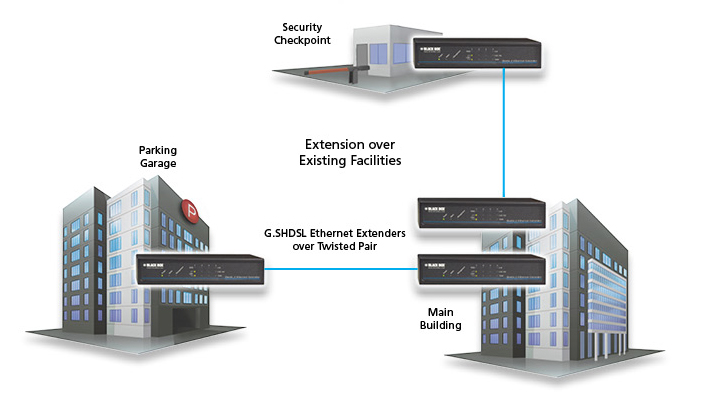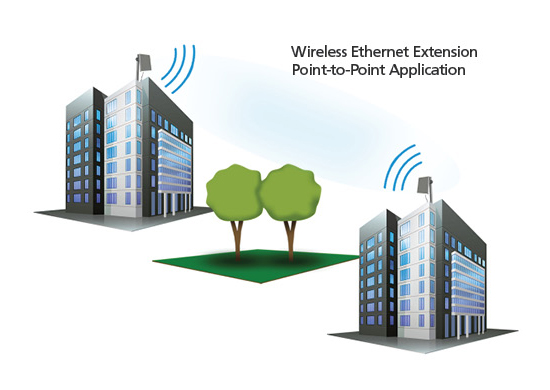Copper CATx cable supports Ethernet distances up to 100 meters. That's not a problem when you're connecting workstations in a building. But what happens when you need to extend the reach of your LAN beyond 100 meters to connect a distant department, a building across campus or across town, Wi-Fi access points, IP security cameras, or even remote monitoring stations in industrial environments.
That's where Ethernet extension comes in. Depending on your environment and application, there are three ways to extend your Ethernet LAN beyond the nearest closet.
1. LAN extension over fiber optic cable with media converters

Media converters are a popular and economical solution for converting Ethernet cable runs from copper to fiber. They can be used in pairs (near-end/far-end) or with Ethernet switches.
Fiber optic cable offers the best performance for long-range network extension. That's why the telephone and cable companies made such a big deal about using it. Multimode fiber has a range of 550 meters for 10/100/1000 Ethernet links. Single-mode fiber offers distances of more than 30 km for 10/100/1000 Ethernet extension.
Fiber also offers the advantage of being immune to electromagnetic interference (EMI), surges, spikes, and ground loops. That makes it well suited for connecting buildings across campus, across town, and in industrial environments.
There are a number of different types of media converter options ranging from simple, unmanaged, compact converters that mount on panels or DIN rails to managed converters that mount in equipment racks. There are also converters available for commercial and industrial applications. A common industrial application is to use a media converter with PoE capabilities to power and backhaul an IP camera signal over fiber.
2. LAN extension over existing copper cabling with Ethernet extenders. In some cases, it's possible to use existing facilities to extend your LAN. If there is an existing twisted-pair copper or coax cable run, then you can extend your network with a pair of Ethernet extenders. Use one at each end to convert Ethernet to DSL (digital subscriber line) and back again to Ethernet. Extenders can deliver 50-Mbps speeds over 300 meters or about 10-Mbps at 1400 meters.
Using existing twisted-pair cabling

A common application is a security checkpoint services upgrade. The checkpoint may have originally been connected only with twisted-pair cable to support an analog phone. By using a pair of Ethernet extenders (near-end/far-end), the checkpoint can be upgraded to support an Ethernet LAN connection, a VoIP phone, and an IP camera.
Using existing coax cabling Another common application is a security camera network upgrade. When you replace older, analog security camera systems with newer, digital IP cameras, you can save a lot of installation time (and labor costs) by using the existing coax cabling with Ethernet extender on each end.
3. Wireless Ethernet extension

2.4-/5-GHz radio extension Wireless Ethernet extenders provide a very cost-effective method for extending a LAN/WAN beyond 100 meters. They eliminate the need to buy new cable, dig expensive trenches for fiber cable, and also the time-consuming waits for rights of way.
Wireless Ethernet extenders are the most seamless way to extend LAN connections up to several miles across office parks; on business, educational, and medical campuses; in enterprise business complexes; and in industrial settings, such as factories or oil/gas field drilling operations, and even in traffic control.
Wireless Ethernet is frequently used to connect line-of-sight networks that are miles apart. While wireless extension is often used in enterprise business applications, where it really shines is in industrial applications, such as data acquisition, control, and monitoring; HVAC controls; and security and surveillance, to name a few. The extender radios can also be PoE powered to simplify installation.
Cellular extension Cellular wireless routers provide an alternative to wireless Ethernet extension. Anywhere you can get cellular phone reception, you can set up a network. Cellular routers can be used to provide the primary network connection for industrial environments where it's too expensive or impractical to run a wired access network, such as cable or DSL. Cellular routers are also used in factories, oil/gas field drilling operations, and in traffic control.
Cellular routers are available for all the major carriers (AT&T, Sprint, and Verizon) and all networks (3G, 4G, and LTE). Cellular routers eliminate any line-of-sight and distance limitations that may exist with radio wireless extension.